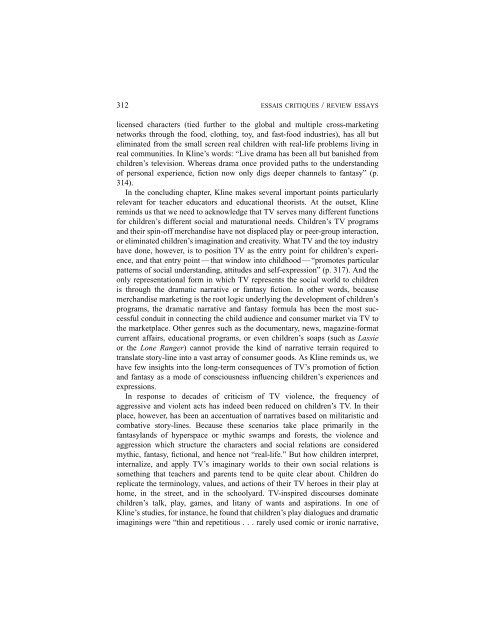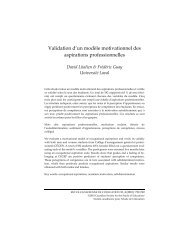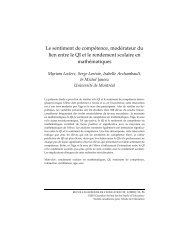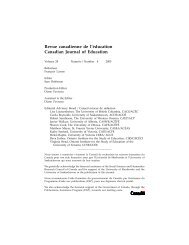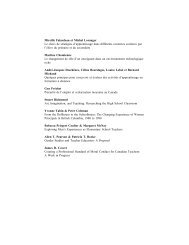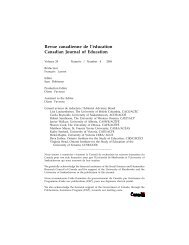Essai Critiques / Review Essays Out of the Garden and Into the Mall
Essai Critiques / Review Essays Out of the Garden and Into the Mall
Essai Critiques / Review Essays Out of the Garden and Into the Mall
You also want an ePaper? Increase the reach of your titles
YUMPU automatically turns print PDFs into web optimized ePapers that Google loves.
312 ESSAIS CRITIQUES / REVIEW ESSAYS<br />
licensed characters (tied fur<strong>the</strong>r to <strong>the</strong> global <strong>and</strong> multiple cross-marketing<br />
networks through <strong>the</strong> food, clothing, toy, <strong>and</strong> fast-food industries), has all but<br />
eliminated from <strong>the</strong> small screen real children with real-life problems living in<br />
real communities. In Kline’s words: “Live drama has been all but banished from<br />
children’s television. Whereas drama once provided paths to <strong>the</strong> underst<strong>and</strong>ing<br />
<strong>of</strong> personal experience, fiction now only digs deeper channels to fantasy” (p.<br />
314).<br />
In <strong>the</strong> concluding chapter, Kline makes several important points particularly<br />
relevant for teacher educators <strong>and</strong> educational <strong>the</strong>orists. At <strong>the</strong> outset, Kline<br />
reminds us that we need to acknowledge that TV serves many different functions<br />
for children’s different social <strong>and</strong> maturational needs. Children’s TV programs<br />
<strong>and</strong> <strong>the</strong>ir spin-<strong>of</strong>f merch<strong>and</strong>ise have not displaced play or peer-group interaction,<br />
or eliminated children’s imagination <strong>and</strong> creativity. What TV <strong>and</strong> <strong>the</strong> toy industry<br />
have done, however, is to position TV as <strong>the</strong> entry point for children’s experience,<br />
<strong>and</strong> that entry point — that window into childhood — “promotes particular<br />
patterns <strong>of</strong> social underst<strong>and</strong>ing, attitudes <strong>and</strong> self-expression” (p. 317). And <strong>the</strong><br />
only representational form in which TV represents <strong>the</strong> social world to children<br />
is through <strong>the</strong> dramatic narrative or fantasy fiction. In o<strong>the</strong>r words, because<br />
merch<strong>and</strong>ise marketing is <strong>the</strong> root logic underlying <strong>the</strong> development <strong>of</strong> children’s<br />
programs, <strong>the</strong> dramatic narrative <strong>and</strong> fantasy formula has been <strong>the</strong> most successful<br />
conduit in connecting <strong>the</strong> child audience <strong>and</strong> consumer market via TV to<br />
<strong>the</strong> marketplace. O<strong>the</strong>r genres such as <strong>the</strong> documentary, news, magazine-format<br />
current affairs, educational programs, or even children’s soaps (such as Lassie<br />
or <strong>the</strong> Lone Ranger) cannot provide <strong>the</strong> kind <strong>of</strong> narrative terrain required to<br />
translate story-line into a vast array <strong>of</strong> consumer goods. As Kline reminds us, we<br />
have few insights into <strong>the</strong> long-term consequences <strong>of</strong> TV’s promotion <strong>of</strong> fiction<br />
<strong>and</strong> fantasy as a mode <strong>of</strong> consciousness influencing children’s experiences <strong>and</strong><br />
expressions.<br />
In response to decades <strong>of</strong> criticism <strong>of</strong> TV violence, <strong>the</strong> frequency <strong>of</strong><br />
aggressive <strong>and</strong> violent acts has indeed been reduced on children’s TV. In <strong>the</strong>ir<br />
place, however, has been an accentuation <strong>of</strong> narratives based on militaristic <strong>and</strong><br />
combative story-lines. Because <strong>the</strong>se scenarios take place primarily in <strong>the</strong><br />
fantasyl<strong>and</strong>s <strong>of</strong> hyperspace or mythic swamps <strong>and</strong> forests, <strong>the</strong> violence <strong>and</strong><br />
aggression which structure <strong>the</strong> characters <strong>and</strong> social relations are considered<br />
mythic, fantasy, fictional, <strong>and</strong> hence not “real-life.” But how children interpret,<br />
internalize, <strong>and</strong> apply TV’s imaginary worlds to <strong>the</strong>ir own social relations is<br />
something that teachers <strong>and</strong> parents tend to be quite clear about. Children do<br />
replicate <strong>the</strong> terminology, values, <strong>and</strong> actions <strong>of</strong> <strong>the</strong>ir TV heroes in <strong>the</strong>ir play at<br />
home, in <strong>the</strong> street, <strong>and</strong> in <strong>the</strong> schoolyard. TV-inspired discourses dominate<br />
children’s talk, play, games, <strong>and</strong> litany <strong>of</strong> wants <strong>and</strong> aspirations. In one <strong>of</strong><br />
Kline’s studies, for instance, he found that children’s play dialogues <strong>and</strong> dramatic<br />
imaginings were “thin <strong>and</strong> repetitious . . . rarely used comic or ironic narrative,


